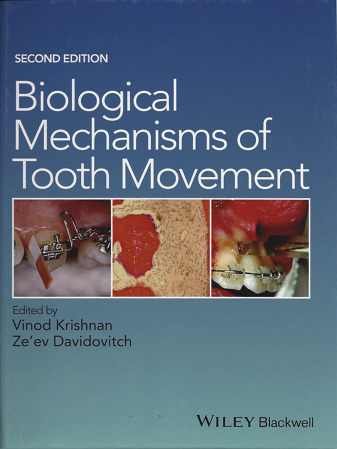
Wiley-Blackwell has published the second edition of Biological Mechanisms of Tooth Movement , a textbook edited by Drs Vinod Krishnan and Ze’ev Davidovitch. Orthodontic tooth movement has been an area of intense research, and significant progress has been made. Traditionally, orthodontic textbooks devote a single chapter at best to the biologic principles behind tooth movement. It is highly commendable that the editors have produced an entire textbook on this important topic; it provides a comprehensive view of all the work that has been done so far. It is truly world class, with contributions from eminent authors and leading experts around the world.
This book is well organized, with 19 chapters split among 7 parts. Each chapter opens with a succinct abstract and has easy-to-follow subtopics. The chapters have high-quality color images, tables, illustrations, and flow charts that allow easy understanding of complex concepts.
In Part 1, the editors, with the help of Rodrigo F. Viecilli, lay the groundwork for their book with a detailed historical perspective and descriptions of the cellular and molecular bases of orthodontic tooth movement. In Part 2, the various contributing authors discuss mechanotransduction of applied forces to hard and soft tissues, bone physiology and metabolism, and the biologic reactions to temporary anchorage devices. The third part of the book looks at controversies and the need for high-quality evidence to understand the effects of orthodontic treatment and periodontal health. This part also covers the current knowledge about the role of inflammation in periodontal tissues in response to orthodontic forces. A chapter on oral fluid biomarkers for tooth movement is also included. Next, the role of genetic factors in orthodontic tooth movement is examined, including the possibilities of personalized orthodontics and the limitation in its application. A chapter on the effects of drugs and medications affecting tooth movement is included in this section. In Part 5, the editors and 3 invited authors discuss the biologic principles, advantages, and shortcomings of various methods to expedite tooth movement. Part 6 sheds light on the biologic determinants of iatrogenic injuries and orthodontic relapse. In the last part of the textbook, the editors identify the controversies in the literature about reducing the duration of orthodontic treatment and, with the help of Rajesh Ramachandran, provide information on sophisticated investigative procedures to advance the field.
This book is written based on best available scientific evidence. It is truly a must-have book for residents, orthodontic clinicians, and researchers alike to gain deeper understanding of the biologic basis of tooth movement, to render the best service to our patients, and to advance our knowledge in this field.
Stay updated, free dental videos. Join our Telegram channel

VIDEdental - Online dental courses


